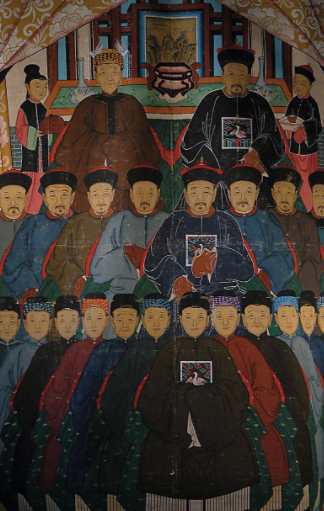How Might Dynasties Have Led To A Stable Government
Developments in Eastward Asia
Government Developments in the Vocal Dynasty
The Sui and Tang Dynasties were able to reunite Red china after centuries of war. The Vocal Dynasty, starting in 960, was able to build on this stability and help advance the government of Prc.
A bureaucracy is fabricated up of all the people who work for the government. The Chinese government was unique for the era, every bit its large bureaucracy was based on merit. Meritocracies are formed based on the abilities of the people versus their wealth and nobility. To help build this large bureaucracy, many took the Civil Service Test.
The Civil Service Examination arrangement started nether the Han Dynasty and reemerged nether the Tang and Vocal. Chinese men would spend years learning the Chinese classics similar The Analects by the famous Chinese philosopher Confucius. Based on their abilities, they would take a series of exams that would accolade them greater power and influence. A person who passed any 1 level of these exams entered a new social course: the scholar gentry. This arroyo to governing lasted until around 1900!

Resources:
Chinese Scholar Gentry. Paradigm Credit: Wikipedia
Economic Development
The stability of the Tang and Song Dynasties allowed for the Chinese to economically develop. A lot of this development was based on their new technologies, regional trade, and their growing dominance.
Below are a series of new developments that helped the Chinese to have the strongest economy between 1200-1450.
Economical Developments in China, 1200-1450
| Grand Canal 🌅 | This canal linked southern China'south Yangtze River with northern China's Yellow River, thus promoting interregional merchandise |
| Gunpowder 💣 | The Chinese invention of gunpowder led to the development of guns and trade forth the Silk Road |
| Champa Rice 🍚 | Champa is a region of Vietnam. Its rice immune for multiple harvests per year. With more harvests came more food and, once information technology was imported to China, a growing population. |
| Coal ⛏ | The vast coal reserves of Red china allowed for the increased production of iron appurtenances. With more iron came more than construction |
| Artisan 🍶 | An artisan is a person who specializes in the making of items similar porcelain and silk. People's republic of china had an emerging artisan class. |
| Public Works 🛣 | The Chinese government built roads and canals due to its wealth, food, and workers, which led to more interregional trade. |
| Tribute System 💰 | The Chinese government was paid a taxation, known as a tribute, by foreign powers. Japan, Korea, and Vietnam all paid Communist china in coin, food, materials, and fifty-fifty workers rather than have to go to war with the superpower! |
| Paper 📜 | The Chinese development and utilize of paper allowed for its government to be more efficient, the arts to thrive, and for paper money to exist used around the dynasty. |
Social Structures in China
The social structure of People's republic of china has been extremely stable since the Han Dynasty. This is because it is very hierarchical. A bureaucracy is a organisation in which people or groups are ranked according to their status.

China's social bureaucracy circa. Han Dynasty
Part of this hierarchy is the fact that China is a patriarchal society where men dominate most systems of power. Though women were charged with raising the children, they rarely were given political or economic roles. This is exemplified in the process of foot binding. Much like mod-solar day cosmetics, foot binding was done to make women more desirable for men too every bit a sign of wealth. 🎥Watch: WHAP - China in the Global Centre Ages
👉 Effort using a study timer like the one in Fiveable rooms to maximize your efficiency when preparing for the test!
Resources:
Periphery of China
A cadre order impacts the societies in its periphery. Much like how the United states impacts nations around it and New York City impacts communities effectually it, China has had a long-lasting impact on the development of Japan, Korea, and Vietnam:
Post-Classical Nippon, Korea, and Vietnam
| Japan | This archipelago (serial of islands) region has unique elements to it like the religion of Shintoism, stories like The Tale of Genji, and a unique feudal hierarchy. The Emperor and Shogun (military leader) would rule over various Daimyo (landowners) who would all hire Samurai to protect their land. The Samurai would practise a unique brand of chivalry chosen the Bushido Code. Though feudal and largely decentralized, Japan was able to develop its own unique society. Though Buddhism did spread to Nihon, the Japanese government did not encompass the civil service system nor did the society accept Confucianism. |
| Korea | Korea has been the virtually influenced by China, adopting Confucianism, Buddhism, and the civil service system. Notwithstanding, the aristocracy in Korea did not allow for social mobility or true unity of the Korean peninsula. |
| Vietnam | Vietnam has tried very hard to maintain its own independence from Red china. Though closely translating to 'southern people', the Vietnamese do not think of themselves as Chinese. They do non accept every bit a hierarchical gild; rather life is dominated past villages and smaller nuclear families. Though Confucianism and Buddhism spread there, the touch of Confucianism is express. |
Source: https://library.fiveable.me/ap-world/unit-1/unit-1-east-asia-1200-1450/study-guide/FYzwf3naOo780ec2cHds

0 Response to "How Might Dynasties Have Led To A Stable Government"
Post a Comment